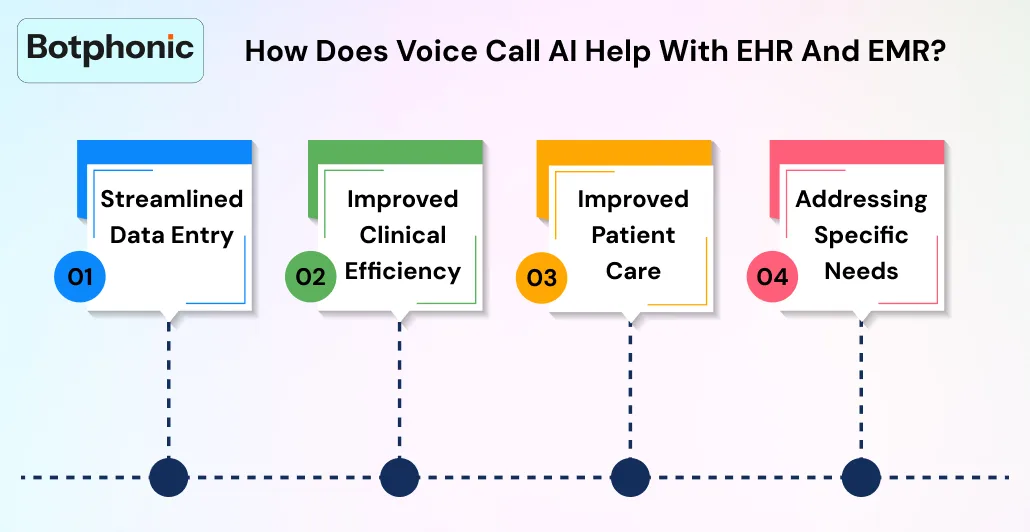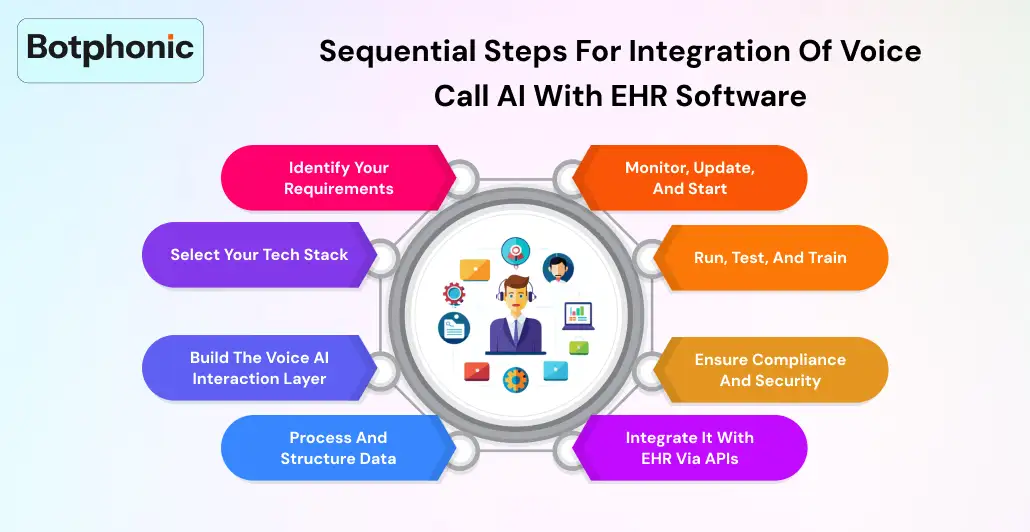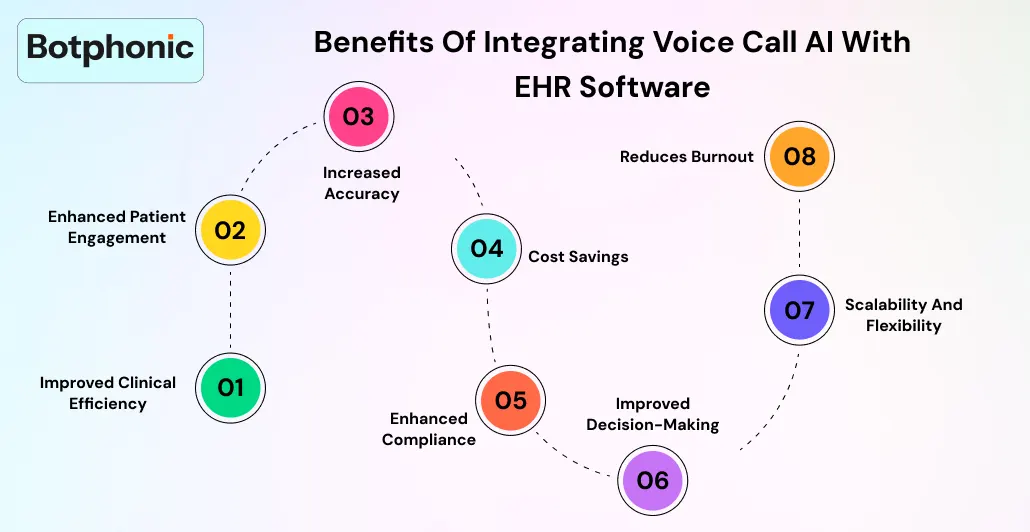
Summarize Content With:
Quick Summary
In this blog, we are going to know what EHR software is and how it’s transforming the healthcare sector, along with voice call AI. By the end of this blog, you will be an expert in how voice calls help with EHR and EMR, too. Also, detailed steps you need to know for integrating the voice AI with the software.
Introduction
Have you been working with patients and gotten tired of looking at screens rather than focusing on people? Don’t worry, we are here to get rid of your stress and introduce you to an AI voice assistant and how you can integrate voice call AI with EHR software for better efficiency and improved job satisfaction. Obviously, if you are working in healthcare, you’d want to care about people in real life rather than always looking at the screen. Let’s know this in detail and walk you through the essential details that you really need to know.
What is an EHR Software?
Electronic Health Record (EHR) is a digitalized version of the paper record method. It helps organize and share details of a patient in a single file, which is accessible to all healthcare providers. With easy access to patients’ records, it makes it easier for doctors to go through patients’ histories and diagnose them. With EHR software, doctors can view and update patients’ diagnosis details in real time, without having to put any manual effort or do an interview with the patient.
How does Voice Call AI help with EHR and EMR?

Healthcare software is using advanced technologies to increase its efficiency and reduce stress on patients and their own team. Speech recognition and natural language processing (NLP) are being optimized successfully for streamlining tasks and prioritizing what actually matters.
Let’s see how voice recognition software in healthcare is being a huge help:
1. Streamlined Data Entry
- Automated Transcription: AI assistants assist in modifying spoken language into text, which enables the healthcare team to save notes, observations, and even treatment plans directly into the system.
- Reduces Manual Input: Automatically pulling out the information from conversations and adding it into the software makes it easier to check details and reduces the need for manual effort.
- Enhanced Data Accuracy: Integrating AI-driven tools can help validate patient information and also detect existing inconsistencies.
- Improved Data Security: IAI can help you implement robust security measures, which will assist you with potential threat detection and protect patients’ data
2. Improved Clinical Efficiency:
- Reduced Burnout: Automating boring and repetitive tasks allows the team to focus on patient health.
- Faster Documentation: Voice-enabled documentation helps clinicians to record information quickly and precisely, or sometimes it might be as soon as they encounter it.
- Better Access to Information: Commands given in voice prompts are usually more effective when compared to others. It helps retrieve information quickly from the EHR or EMR.
- Improved Communication: Using Voice AI healthcare aids the communication between healthcare providers and patients.
3. Improved Patient Care
- Faster Clinical Decision Support: AI provides assistance with real-time access to doctors, which makes it easier for them to make decisions regarding patients’ diagnoses.
- Personalized Care: Analyzing patient data, these virtual assistants can help identify what could be potential issues with the patient. And can recommend a customized healthcare plan.
- Remote Patient Monitoring: Integrating it with remote patient monitoring systems allows healthcare providers to track their patients’ records. Helps them monitor vital signs and symptoms even if they are not with them at present time.
- Enhanced Patient Engagement: Voice-enabled tools help not just healthcare practitioners but outpatients too. It helps them assess their own information, and with appointment reminders and medication schedules too.
4. Addressing Specific Needs
- Medication Management: With voice call A, you can use it to send medication reminders. Also, helps with details regarding drug interaction.
- Appointment Scheduling and Reminders: Handling appointments and reminders has never been better. With healthcare software, it enables you to reduce the administrative burden.
- Multilingual Support: Supporting patients with diverse language backgrounds and helping them by providing assistance has become easy by using these interactive AI models.
- Triage and Support: EHR AI can help you in assisting patient triage. By regularly assessing their needs and directing them to their appropriate care.
By using voice call AI, clinicians have been increasing their operational efficiency and reducing costs too.
Sequential Steps for Integration of Voice Call AI with EHR Software

Integrating voice call AI with EHR software involves an organized approach. Even though it enhances decision-making and effectively helps with task streamlining. For improving your patient care approach, here’s a structured guide to ensure you are doing good with implementation.
1. Identify Your Requirements
Before adding to any software, ensure what your needs are. Who are the users for your platform, whether it’s just doctors and patients, or does it include other staff too? What’s the integration type?
2. Select Your Tech Stack
Choose a technology stack that suits your needs. And look for an appropriate voice AI call platform such as Google Dialogflow CX, Amazon Lex, Botphonic, or others. Also, look out for a good EHR system and if the platform incorporates NLP and medical intelligence.
3. Build the Voice AI Interaction Layer
Ensure what you voice AI does,
- Does it receive or initiate the calls?
- Can you use speech-to-text effectively?
- And also does it apply NLP to extract data, such as:
- Symptoms
- Appointment intent
- Medications mentioned
- Follow-up needs
4. Process and Structure Data
After ensuring transcription and NLP, clean the text, apply your required templates, and map out voice-extracted entities to EHR-compatible fields.
5. Integrate it with EHR via APIs
Don’t forget to use the Fast Healthcare Interoperability Resources standard whenever it’s possible. Some common EHR data points are:
| EHR Component | FHIR Resource |
| Patient Demographics | Patient |
| Vital Signs | Observation |
| Notes | DocumentReference or Encounter |
| Medications | MedicationRequest |
| Appointments | Appointment |
6. Ensure Compliance and Security
Ensure that the platform you have chosen handles patients’ data in accordance with HIPAA. And is secure to use.
7. Run, Test, and Train
Run a small start test with a small group of clinicians and patients to ensure its effectiveness and workflow structure. You can choose some of the focus areas at the initial stage as:
- Voice accuracy
- Clinical relevance of NLP output
- Accuracy of EHR entries
8. Monitor, Update, and Start
After deploying the same, ensure to:
- Continuously monitor performance, errors, and usage
- Collect feedback from clinicians
- Expand it to more departments
Also, ensure to use the dashboard to track:
- Time saved per encounter
- Reduction in manual documentation
- Accuracy of AI-generated notes
Example of Workflow:
- The patient calls the clinic number
- Voice AI answers → asks triage questions
- Transcribes and extracts key info
- Sends structured summary to EHR via FHIR API
- The doctor sees the summary before the appointment
Benefits Of Integrating Voice Call AI With EHR Software

1. Improved Clinical Efficiency
An AI call assistant effectively helps with transcribing and structuring the clinical conversations. It also assists with adding notes, vitals, and even patient-reported symptoms to the EHR in real-time. Increasing the overall efficiency of working.
2. Enhanced Patient Engagement
This voice call AI assists with effective handling of patient inquiries, appointment booking, and even with basic triage at any time when required. It can readily find the information from the EHR and provide a personalized feel to the patients. Even for elderly or visually challenged patients, it helps them interact through voice rather than digital portals.
3. Increased Accuracy
With AI healthcare bots that are trained especially with medical terminology, it ensures accurate note-taking. Adding structured data fields improved data of records with quality and consistency. By effectively eliminating reliance on memory, it reduces the risk of error.
4. Cost Savings
Incorporating efficient AI tools aids in reducing the need for scribes or other call center solutions. Improving data accuracy results in fewer errors and duplications, too. With real-time data and analytics, it let providers can improve their care quality.
5. Enhanced Compliance
AI supports improvised transcription and stores the interaction details of the patient securely for compliance and legal review. With effective audit trails, every interaction is documented, and EHR details are updated and logged.
6. Improved Decision-Making
Optimizing call AI supports surface patients’ history or highlights issues while being on call for better decision-making regarding the diagnosis. IT can automatically trigger alerts, orders, or even follow-ups based on the conversation.
7. Scalability and Flexibility
These AI voice call bots can easily be expanded across departments for triage, billing, or even post-discharge calls. With its multilingual capabilities, it supports patients who speak different languages, too. And with standardized protocols, such as FHIR, it makes integration portable and modular, too.
8. Reduces Burnout
By automating tasks that need the same procedure again and again, AI frees clinicians to focus on patient care. And let providers spend more time interacting face-to-face with people rather than being stuck at a place and staring at a screen the whole day.
With numerous benefits, integrating voice call AI with EHR software will never go wrong. It helps you focus on your patients rather than being focused on screens all the time.
Conclusion
Integrating voice call AI with EHR software helps healthcare providers focus on patients’ health rather than just collecting the information and organizing it. It helps you share all the data on a single platform and can monitor whenever it seems required. By streamlining tasks such as data entry and appointment scheduling, AI lets clinicians improve patient care and enhance clinical efficiency, along with decision-making.

